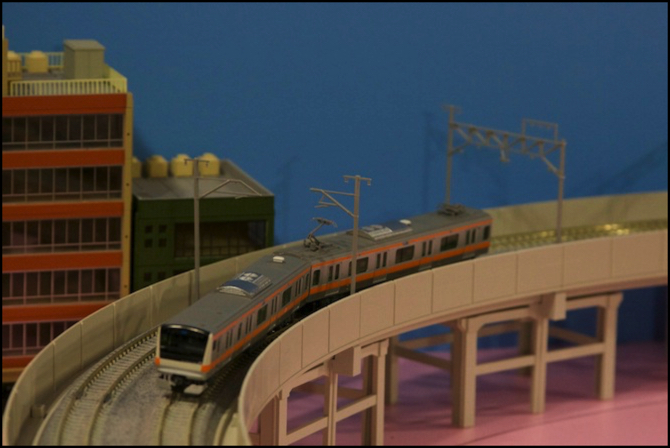Looking at Catenary
20 January 2010 01:05 Filed in: Design

Catenary, the wire hanging above the track, is a significant scenic element of an electric railroad line. There are many types of catenary wiring, and probably even more types of poles or other structures from which it hangs. Some of this is described in my Prototype Catenary page, although there is limited detail available online.
Different lines may use different catenary, and the same line can use different kinds of poles on different sections, so this is a detail that can be used to give character to a particular scene. As part of my planning of the river-crossing scene, I started looking at viaduct track and how the catenary worked with it, as well as looking at what issues I’d have putting two sets of double track next to each other. And, unfortunately, I found plenty of things to worry about.
That led me to search out information about prototype Japanese catenary, which turned out to be in short supply, and take a close look at what options I had with Kato’s Unitrack. While there are other options, including building my own, I decided to start with the off-the-shelf solutions that would work best with the track I planned to use, if that’s practical. I can always decide later to do something more complex.
In the picture above, two types of Kato catenary are illustrated, a pair of single poles with a cantilevered hanger, and a double-track truss with a simple set of insulators used to hang wire. For some more photos, and many words about the options Unitrack provides, see my first Catenary page. There are two additional pages, linked from the first, that go into some more detail about Kato’s track and catenary.
One of the interesting things I discovered was that Kato has two different widths of catenary. The two types shown above are what I call “narrow” or “inside the viaduct” poles. I think these look better. However, with the “uperelevated double track curved track (both viaduct and non-viaduct), Kato introduced a new type, which I call “wide” or “outside the viaduct”. The “inside” or “outside” name comes from how the bases and poles mount to viaduct supports: “inside” poles (seen above) are attached to bases that stick up inside the walls of the viaduct. The “outside” poles have bases below the viaduct that stick off to the side, and the poles run up outside of the viaduct walls. You can actually find both kinds of mounting on the prototype, but I don’t like the look of the “outside” ones on Kato’s viaducts.
I wanted to use the single-track poles with the outer, or “Shinkansen”, pair of tracks. However, these only look good on “narrow” bases, and it would appear Kato has concerns about clearance when using superelevated track with the “narrow” style of catenary. I can’t find any specific cautions about this, but they introduced the new wide bases alongside the superelevated curves, and some quick tests showed me that while my current trains would work, the clearances were close. I strongly suspect longer, or “tilting” trains like the N700 Shinkansen, would have clearance problems with the narrow spacing on superelevated curves.
Kato also seems to be phasing out the narrow viaduct catenary bases as they switch their viaducts over to the new superelevated track, as they’ve discontinued the older set of viaduct piers that contained these bases (you can still find them on the “poured concrete” piers used for bridges though). However, the narrow non-viaduct bases and poles have not been discontinued.
Another problem is that I have a four-track stretch on this scene, and there were clearance problems simply putting two sets of track, each with their own poles, next to each other. These were workable with ground-level track and narrow bases, but became problems if I put one of the tracks in viaduct, or used wide bases.
Finally, there’s a matter of style. Examining a number of photographs of Shinkansen lines, I can see that the wide double-track poles aren’t really appropriate, as they use a simple insulator style of hanger, rather than the cantilever style used on the single-track poles and the “Modern Double Track Catenary” set of poles. Unfortunately, both of those only really work for narrow bases, which means using superelevated track with Shinkansen would force me to use the wrong style of catenary pole.
I haven’t yet decided how I’m going to work this out. I could end up building my own four-track poles, or I may decide to take a risk on the narrow bases.




